GMC CANYON 2009 Manual Online
Manufacturer: GMC, Model Year: 2009, Model line: CANYON, Model: GMC CANYON 2009Pages: 414, PDF Size: 2.48 MB
Page 81 of 414
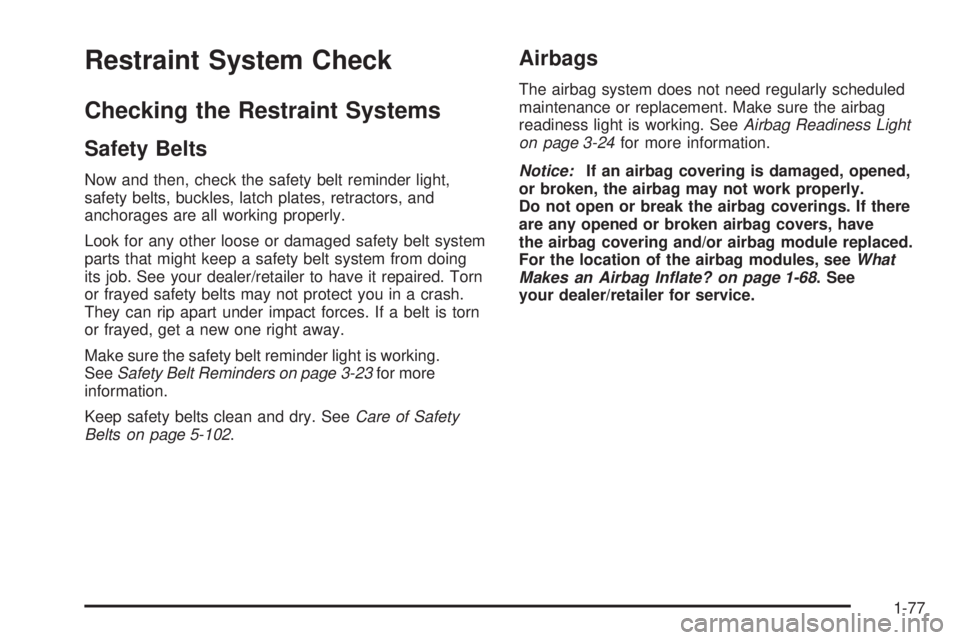
Restraint System Check
Checking the Restraint Systems
Safety Belts
Now and then, check the safety belt reminder light,
safety belts, buckles, latch plates, retractors, and
anchorages are all working properly.
Look for any other loose or damaged safety belt system
parts that might keep a safety belt system from doing
its job. See your dealer/retailer to have it repaired. Torn
or frayed safety belts may not protect you in a crash.
They can rip apart under impact forces. If a belt is torn
or frayed, get a new one right away.
Make sure the safety belt reminder light is working.
SeeSafety Belt Reminders on page 3-23for more
information.
Keep safety belts clean and dry. SeeCare of Safety
Belts on page 5-102.
Airbags
The airbag system does not need regularly scheduled
maintenance or replacement. Make sure the airbag
readiness light is working. SeeAirbag Readiness Light
on page 3-24for more information.
Notice:If an airbag covering is damaged, opened,
or broken, the airbag may not work properly.
Do not open or break the airbag coverings. If there
are any opened or broken airbag covers, have
the airbag covering and/or airbag module replaced.
For the location of the airbag modules, seeWhat
Makes an Airbag Inflate? on page 1-68. See
your dealer/retailer for service.
1-77
Page 82 of 414
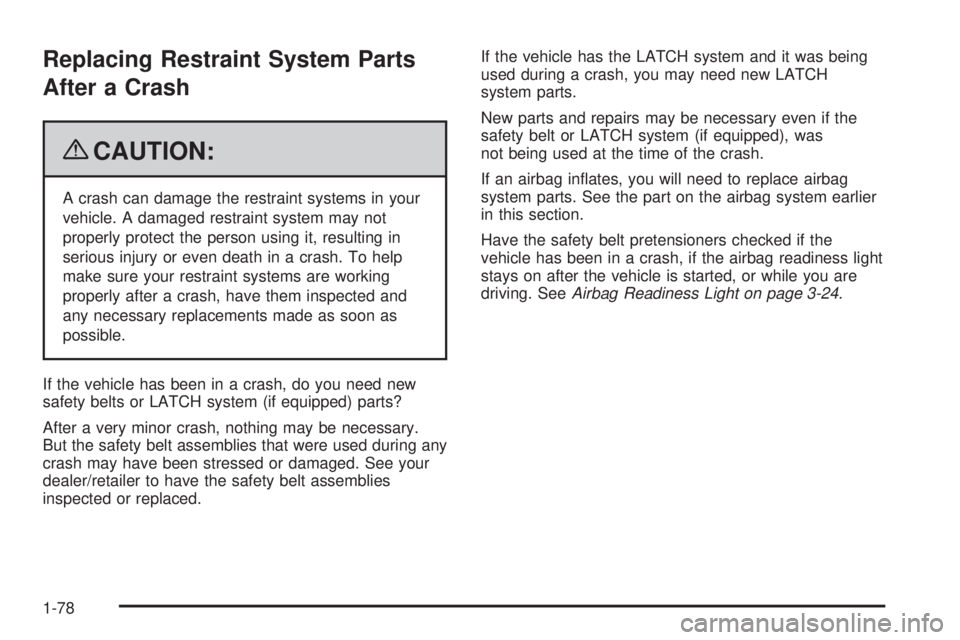
Replacing Restraint System Parts
After a Crash
{CAUTION:
A crash can damage the restraint systems in your
vehicle. A damaged restraint system may not
properly protect the person using it, resulting in
serious injury or even death in a crash. To help
make sure your restraint systems are working
properly after a crash, have them inspected and
any necessary replacements made as soon as
possible.
If the vehicle has been in a crash, do you need new
safety belts or LATCH system (if equipped) parts?
After a very minor crash, nothing may be necessary.
But the safety belt assemblies that were used during any
crash may have been stressed or damaged. See your
dealer/retailer to have the safety belt assemblies
inspected or replaced.If the vehicle has the LATCH system and it was being
used during a crash, you may need new LATCH
system parts.
New parts and repairs may be necessary even if the
safety belt or LATCH system (if equipped), was
not being used at the time of the crash.
If an airbag in�ates, you will need to replace airbag
system parts. See the part on the airbag system earlier
in this section.
Have the safety belt pretensioners checked if the
vehicle has been in a crash, if the airbag readiness light
stays on after the vehicle is started, or while you are
driving. SeeAirbag Readiness Light on page 3-24.
1-78
Page 83 of 414
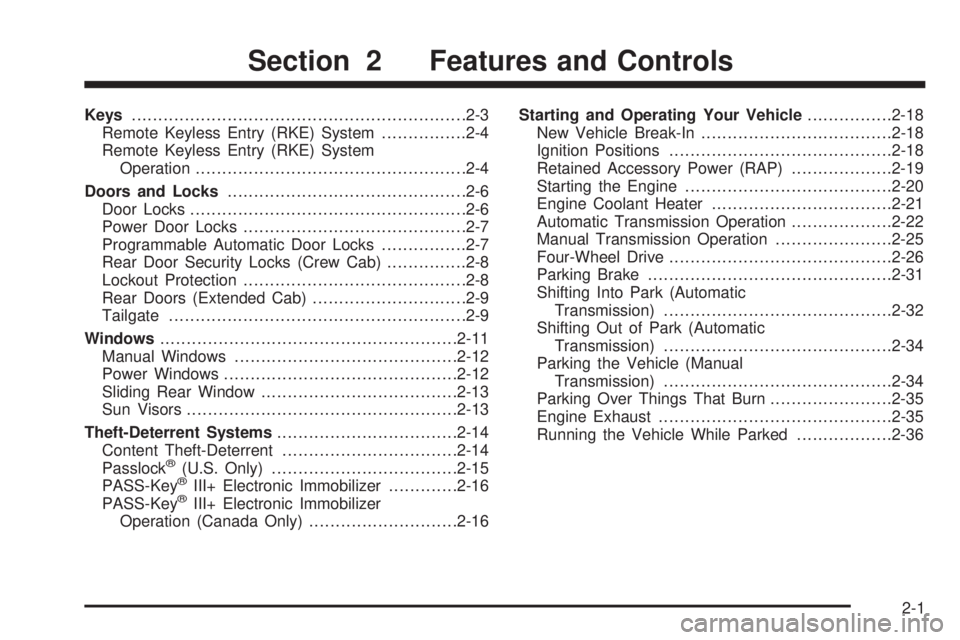
Keys...............................................................2-3
Remote Keyless Entry (RKE) System................2-4
Remote Keyless Entry (RKE) System
Operation...................................................2-4
Doors and Locks.............................................2-6
Door Locks....................................................2-6
Power Door Locks..........................................2-7
Programmable Automatic Door Locks................2-7
Rear Door Security Locks (Crew Cab)...............2-8
Lockout Protection..........................................2-8
Rear Doors (Extended Cab).............................2-9
Tailgate........................................................2-9
Windows........................................................2-11
Manual Windows..........................................2-12
Power Windows............................................2-12
Sliding Rear Window.....................................2-13
Sun Visors...................................................2-13
Theft-Deterrent Systems..................................2-14
Content Theft-Deterrent.................................2-14
Passlock
®(U.S. Only)...................................2-15
PASS-Key®III+ Electronic Immobilizer.............2-16
PASS-Key®III+ Electronic Immobilizer
Operation (Canada Only)............................2-16Starting and Operating Your Vehicle................2-18
New Vehicle Break-In....................................2-18
Ignition Positions..........................................2-18
Retained Accessory Power (RAP)...................2-19
Starting the Engine.......................................2-20
Engine Coolant Heater..................................2-21
Automatic Transmission Operation...................2-22
Manual Transmission Operation......................2-25
Four-Wheel Drive..........................................2-26
Parking Brake..............................................2-31
Shifting Into Park (Automatic
Transmission)...........................................2-32
Shifting Out of Park (Automatic
Transmission)...........................................2-34
Parking the Vehicle (Manual
Transmission)...........................................2-34
Parking Over Things That Burn.......................2-35
Engine Exhaust............................................2-35
Running the Vehicle While Parked..................2-36
Section 2 Features and Controls
2-1
Page 84 of 414
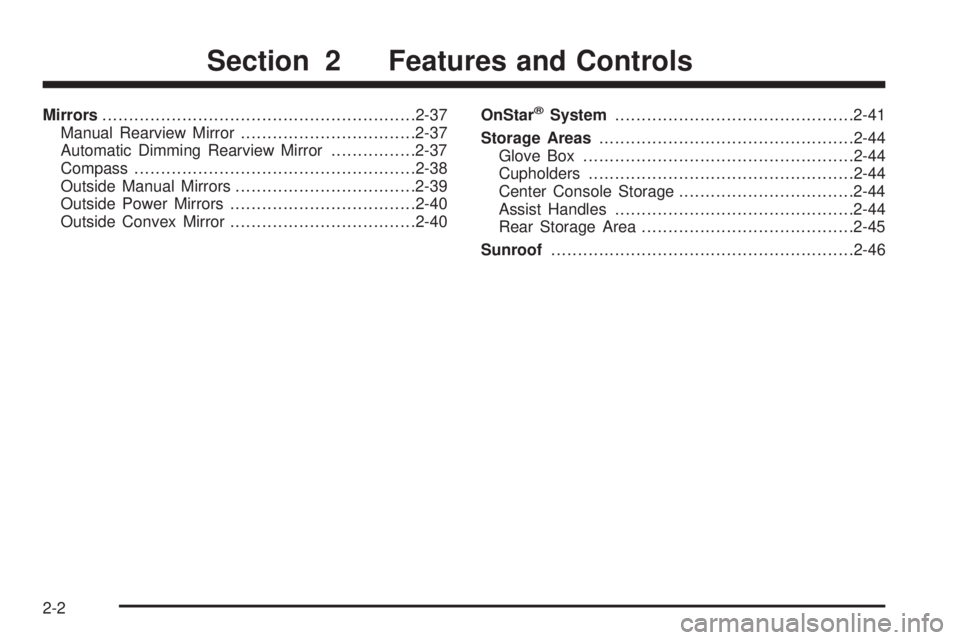
Mirrors...........................................................2-37
Manual Rearview Mirror.................................2-37
Automatic Dimming Rearview Mirror................2-37
Compass.....................................................2-38
Outside Manual Mirrors..................................2-39
Outside Power Mirrors...................................2-40
Outside Convex Mirror...................................2-40OnStar®System.............................................2-41
Storage Areas................................................2-44
Glove Box...................................................2-44
Cupholders..................................................2-44
Center Console Storage.................................2-44
Assist Handles.............................................2-44
Rear Storage Area........................................2-45
Sunroof.........................................................2-46
Section 2 Features and Controls
2-2
Page 85 of 414
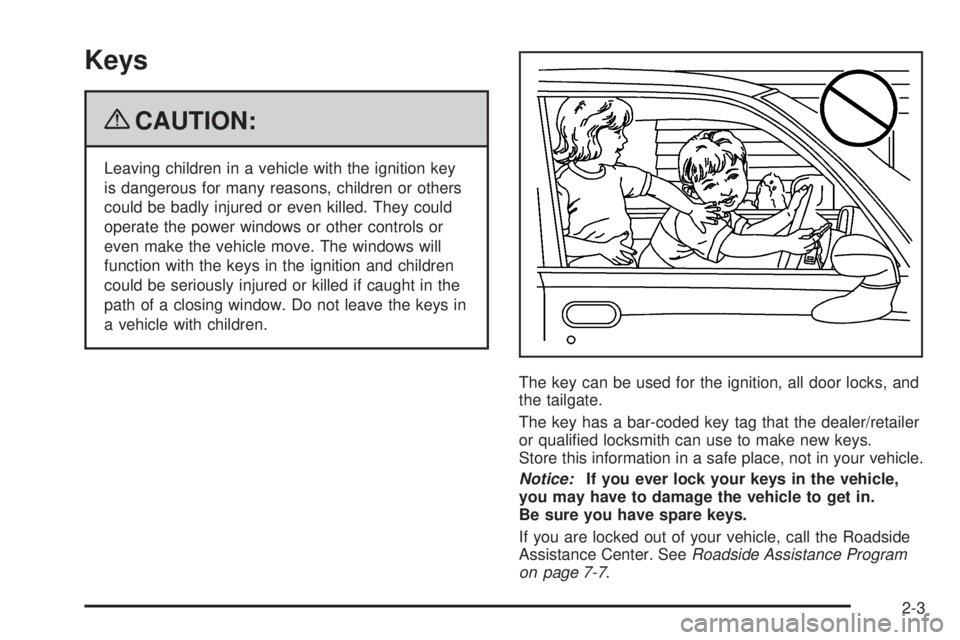
Keys
{CAUTION:
Leaving children in a vehicle with the ignition key
is dangerous for many reasons, children or others
could be badly injured or even killed. They could
operate the power windows or other controls or
even make the vehicle move. The windows will
function with the keys in the ignition and children
could be seriously injured or killed if caught in the
path of a closing window. Do not leave the keys in
a vehicle with children.
The key can be used for the ignition, all door locks, and
the tailgate.
The key has a bar-coded key tag that the dealer/retailer
or quali�ed locksmith can use to make new keys.
Store this information in a safe place, not in your vehicle.
Notice:If you ever lock your keys in the vehicle,
you may have to damage the vehicle to get in.
Be sure you have spare keys.
If you are locked out of your vehicle, call the Roadside
Assistance Center. SeeRoadside Assistance Program
on page 7-7.
2-3
Page 86 of 414
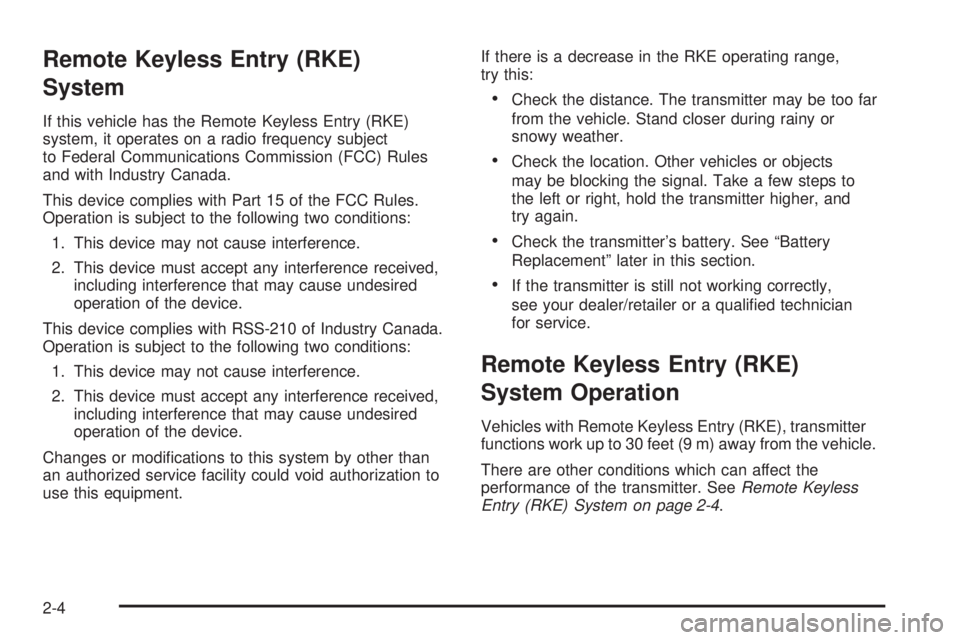
Remote Keyless Entry (RKE)
System
If this vehicle has the Remote Keyless Entry (RKE)
system, it operates on a radio frequency subject
to Federal Communications Commission (FCC) Rules
and with Industry Canada.
This device complies with Part 15 of the FCC Rules.
Operation is subject to the following two conditions:
1. This device may not cause interference.
2. This device must accept any interference received,
including interference that may cause undesired
operation of the device.
This device complies with RSS-210 of Industry Canada.
Operation is subject to the following two conditions:
1. This device may not cause interference.
2. This device must accept any interference received,
including interference that may cause undesired
operation of the device.
Changes or modi�cations to this system by other than
an authorized service facility could void authorization to
use this equipment.If there is a decrease in the RKE operating range,
try this:
Check the distance. The transmitter may be too far
from the vehicle. Stand closer during rainy or
snowy weather.
Check the location. Other vehicles or objects
may be blocking the signal. Take a few steps to
the left or right, hold the transmitter higher, and
try again.
Check the transmitter’s battery. See “Battery
Replacement” later in this section.
If the transmitter is still not working correctly,
see your dealer/retailer or a quali�ed technician
for service.
Remote Keyless Entry (RKE)
System Operation
Vehicles with Remote Keyless Entry (RKE), transmitter
functions work up to 30 feet (9 m) away from the vehicle.
There are other conditions which can affect the
performance of the transmitter. SeeRemote Keyless
Entry (RKE) System on page 2-4.
2-4
Page 87 of 414

UNLOCK:Press to unlock
the driver door and turn on
the interior lamps. The
parking lamps may �ash
and the horn may sound.
Press UNLOCK again within three seconds and all of
the doors unlock.
LOCK:Press to lock all the doors. The parking lamps
may �ash and the horn may sound.
If a door is open or ajar when LOCK is pressed, the
horn sounds several times to let you know the doors did
not lock and the content theft-deterrent system is not
armed. Pressing LOCK again while the horn is sounding
or within three seconds after the horn stops sounding,
the doors lock but the content theft-deterrent system
does not arm until the opened door is closed.Different feedback modes can be programmed through
the Driver Information Center (DIC). See “Remote
Keyless Entry Feedback” underDIC Operation and
Displays on page 3-35.
L(Panic):Press to make the horn sound and the
headlamps and taillamps �ash for up to 30 seconds.
To turn them off wait for 30 seconds, or press
Lagain,
or start the vehicle.
Programming Transmitters to
the Vehicle
Only RKE transmitters programmed to the vehicle will
work. If a transmitter is lost or stolen, a replacement
can be purchased and programmed through your
dealer/retailer. When the replacement transmitter is
programmed to the vehicle, all remaining transmitters
must also be programmed. Any lost or stolen
transmitters no longer work once the new transmitter
is programmed. Each vehicle can have up to
four transmitters programmed to it.
2-5
Page 88 of 414
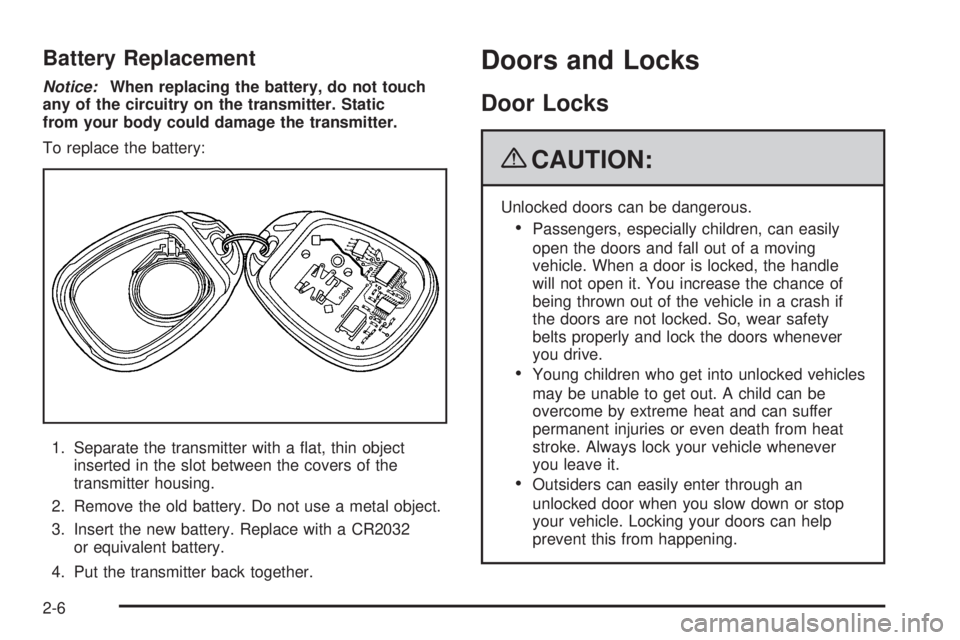
Battery Replacement
Notice:When replacing the battery, do not touch
any of the circuitry on the transmitter. Static
from your body could damage the transmitter.
To replace the battery:
1. Separate the transmitter with a �at, thin object
inserted in the slot between the covers of the
transmitter housing.
2. Remove the old battery. Do not use a metal object.
3. Insert the new battery. Replace with a CR2032
or equivalent battery.
4. Put the transmitter back together.
Doors and Locks
Door Locks
{CAUTION:
Unlocked doors can be dangerous.
Passengers, especially children, can easily
open the doors and fall out of a moving
vehicle. When a door is locked, the handle
will not open it. You increase the chance of
being thrown out of the vehicle in a crash if
the doors are not locked. So, wear safety
belts properly and lock the doors whenever
you drive.
Young children who get into unlocked vehicles
may be unable to get out. A child can be
overcome by extreme heat and can suffer
permanent injuries or even death from heat
stroke. Always lock your vehicle whenever
you leave it.
Outsiders can easily enter through an
unlocked door when you slow down or stop
your vehicle. Locking your doors can help
prevent this from happening.
2-6
Page 89 of 414
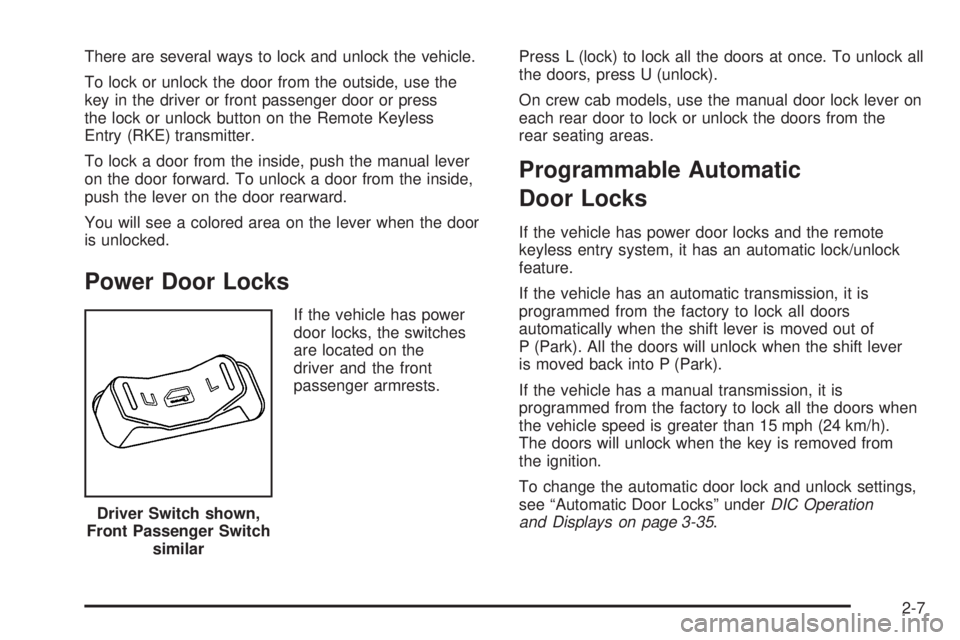
There are several ways to lock and unlock the vehicle.
To lock or unlock the door from the outside, use the
key in the driver or front passenger door or press
the lock or unlock button on the Remote Keyless
Entry (RKE) transmitter.
To lock a door from the inside, push the manual lever
on the door forward. To unlock a door from the inside,
push the lever on the door rearward.
You will see a colored area on the lever when the door
is unlocked.
Power Door Locks
If the vehicle has power
door locks, the switches
are located on the
driver and the front
passenger armrests.Press L (lock) to lock all the doors at once. To unlock all
the doors, press U (unlock).
On crew cab models, use the manual door lock lever on
each rear door to lock or unlock the doors from the
rear seating areas.
Programmable Automatic
Door Locks
If the vehicle has power door locks and the remote
keyless entry system, it has an automatic lock/unlock
feature.
If the vehicle has an automatic transmission, it is
programmed from the factory to lock all doors
automatically when the shift lever is moved out of
P (Park). All the doors will unlock when the shift lever
is moved back into P (Park).
If the vehicle has a manual transmission, it is
programmed from the factory to lock all the doors when
the vehicle speed is greater than 15 mph (24 km/h).
The doors will unlock when the key is removed from
the ignition.
To change the automatic door lock and unlock settings,
see “Automatic Door Locks” underDIC Operation
and Displays on page 3-35. Driver Switch shown,
Front Passenger Switch
similar
2-7
Page 90 of 414
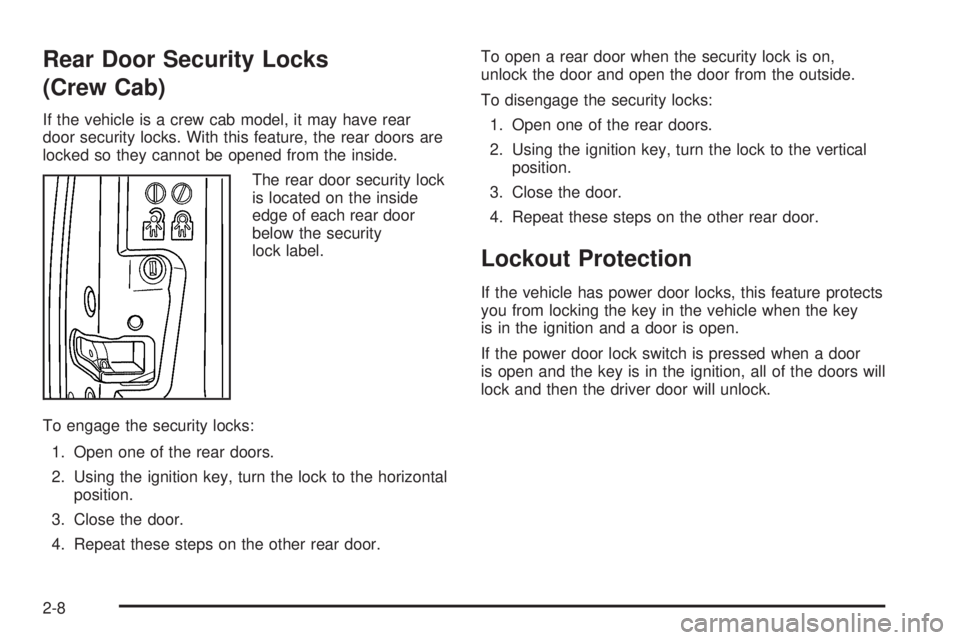
Rear Door Security Locks
(Crew Cab)
If the vehicle is a crew cab model, it may have rear
door security locks. With this feature, the rear doors are
locked so they cannot be opened from the inside.
The rear door security lock
is located on the inside
edge of each rear door
below the security
lock label.
To engage the security locks:
1. Open one of the rear doors.
2. Using the ignition key, turn the lock to the horizontal
position.
3. Close the door.
4. Repeat these steps on the other rear door.To open a rear door when the security lock is on,
unlock the door and open the door from the outside.
To disengage the security locks:
1. Open one of the rear doors.
2. Using the ignition key, turn the lock to the vertical
position.
3. Close the door.
4. Repeat these steps on the other rear door.
Lockout Protection
If the vehicle has power door locks, this feature protects
you from locking the key in the vehicle when the key
is in the ignition and a door is open.
If the power door lock switch is pressed when a door
is open and the key is in the ignition, all of the doors will
lock and then the driver door will unlock.
2-8